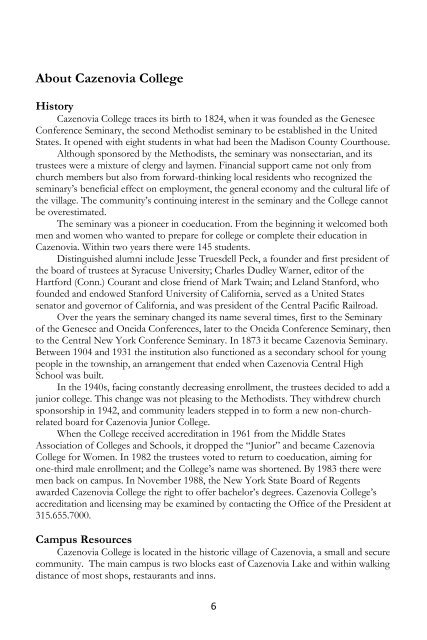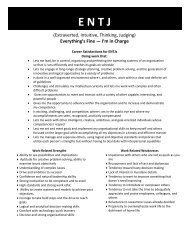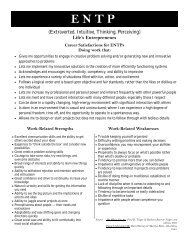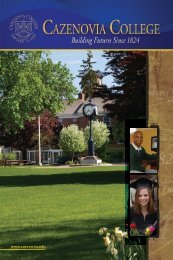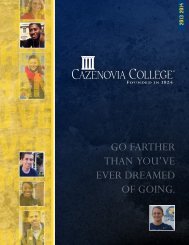Named one of “America’s Best Colleges” by U.S News & World Report
2011-12 Academic Catalog - Cazenovia College
2011-12 Academic Catalog - Cazenovia College
- No tags were found...
You also want an ePaper? Increase the reach of your titles
YUMPU automatically turns print PDFs into web optimized ePapers that Google loves.
About Cazenovia College<br />
History<br />
Cazenovia College traces its birth to 1824, when it was founded as the Genesee<br />
Conference Seminary, the second Methodist seminary to be established in the United<br />
States. It opened with eight students in what had been the Madison County Courthouse.<br />
Although sponsored <strong>by</strong> the Methodists, the seminary was nonsectarian, and its<br />
trustees were a mixture <strong>of</strong> clergy and laymen. Financial support came not only from<br />
church members but also from forward-thinking local residents who recognized the<br />
seminary‘s beneficial effect on employment, the general economy and the cultural life <strong>of</strong><br />
the village. The community‘s continuing interest in the seminary and the College cannot<br />
be overestimated.<br />
The seminary was a pi<strong>one</strong>er in coeducation. From the beginning it welcomed both<br />
men and women who wanted to prepare for college or complete their education in<br />
Cazenovia. Within two years there were 145 students.<br />
Distinguished alumni include Jesse Truesdell Peck, a founder and first president <strong>of</strong><br />
the board <strong>of</strong> trustees at Syracuse University; Charles Dudley Warner, editor <strong>of</strong> the<br />
Hartford (Conn.) Courant and close friend <strong>of</strong> Mark Twain; and Leland Stanford, who<br />
founded and endowed Stanford University <strong>of</strong> California, served as a United States<br />
senator and governor <strong>of</strong> California, and was president <strong>of</strong> the Central Pacific Railroad.<br />
Over the years the seminary changed its name several times, first to the Seminary<br />
<strong>of</strong> the Genesee and Oneida Conferences, later to the Oneida Conference Seminary, then<br />
to the Central New York Conference Seminary. In 1873 it became Cazenovia Seminary.<br />
Between 1904 and 1931 the institution also functi<strong>one</strong>d as a secondary school for young<br />
people in the township, an arrangement that ended when Cazenovia Central High<br />
School was built.<br />
In the 1940s, facing constantly decreasing enrollment, the trustees decided to add a<br />
junior college. This change was not pleasing to the Methodists. They withdrew church<br />
sponsorship in 1942, and community leaders stepped in to form a new non-churchrelated<br />
board for Cazenovia Junior College.<br />
When the College received accreditation in 1961 from the Middle States<br />
Association <strong>of</strong> Colleges and Schools, it dropped the ―Junior‖ and became Cazenovia<br />
College for Women. In 1982 the trustees voted to return to coeducation, aiming for<br />
<strong>one</strong>-third male enrollment; and the College‘s name was shortened. By 1983 there were<br />
men back on campus. In November 1988, the New York State Board <strong>of</strong> Regents<br />
awarded Cazenovia College the right to <strong>of</strong>fer bachelor‘s degrees. Cazenovia College‘s<br />
accreditation and licensing may be examined <strong>by</strong> contacting the Office <strong>of</strong> the President at<br />
315.655.7000.<br />
Campus Resources<br />
Cazenovia College is located in the historic village <strong>of</strong> Cazenovia, a small and secure<br />
community. The main campus is two blocks east <strong>of</strong> Cazenovia Lake and within walking<br />
distance <strong>of</strong> most shops, restaurants and inns.<br />
6


